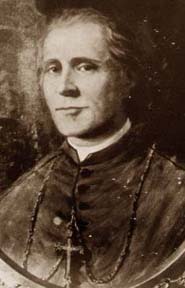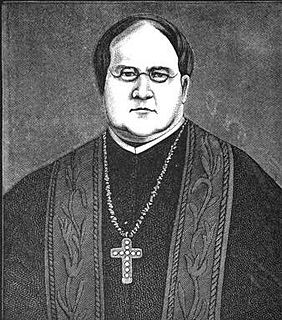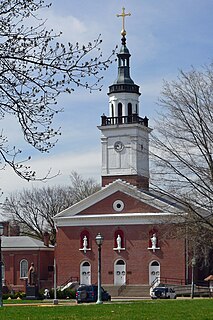Related Research Articles

William J. Quarter was an Irish American prelate of the Catholic Church. He was the first Bishop of Chicago (1844–1848).

John Baptist Purcell was an Irish-born prelate of the Catholic Church. He served as Bishop of Cincinnati from 1833 to his death in 1883, and he was elevated to the rank of archbishop in 1850. He formed the basis of Father Ferrand, the Ohio-based "Irish by birth, French by ancestry" character in the prologue of Willa Cather's historical novel Death Comes for the Archbishop who goes to Rome asking for a bishop for New Mexico Territory.

The Roman Catholic Archdiocese of Indianapolis is a division of the Roman Catholic Church in the United States. When it was originally erected as the Diocese of Vincennes on May 6, 1834, it encompassed all of Indiana as well as the eastern third of Illinois. It was renamed the Diocese of Indianapolis on March 28, 1898. Bishop Francis Silas Chatard, who had been living in Indianapolis since 1878 when he was appointed Bishop of Vincennes, became the first Bishop of Indianapolis. It was elevated from a diocese to a metropolitan archdiocese on October 21, 1944.

Benedict Joseph Flaget was a French-born Catholic bishop in the United States. He served as the Bishop of the Roman Catholic Diocese of Bardstown between 1808 and 1839. When the see was transferred to Louisville in 1839, he became Bishop of the Diocese of Louisville where he served from 1839 to 1850.

Bishop Michael Portier was a Roman Catholic bishop in the United States and the first Bishop of Mobile. He immigrated to the US in 1817, being ordained there. He later founded many parishes and Catholic institutions in Alabama and Florida, particularly in Mobile. Among them was Providence Hospital. He also recruited religious orders of men and women to teach and care for parishioners.

Silas Francis Marean Chatard was a Roman Catholic Bishop of Indianapolis in the United States.

The Diocese of Evansville is a diocese of the Catholic Church in Southwestern Indiana.

Simon William Gabriel Bruté de Rémur was a French missionary in the United States and the first bishop of the Diocese of Vincennes, Indiana. President John Quincy Adams called Bruté "the most learned man of his day in America."
George Aloysius Carrell, S.J. was an American prelate of the Roman Catholic Church who served as the first bishop of the Diocese of Covington, Kentucky from 1853 until his death in 1868.
Benjamin Marie Petit was a Catholic missionary to the Potawatomi at Twin Lakes, Indiana, where he served from November 1837 to September 1838. A native of Rennes in Brittany, France, Petit was trained as a lawyer at the University of Rennes, but left the profession after three years to enter the Saint-Sulpice Seminary in Paris to study for the priesthood. In 1836 he decided to move to the United States to become a missionary among the Native Americans. He traveled to New York with a group led by Bishop Simon Bruté, the first bishop of the Catholic Diocese of Vincennes. Petit was sent to Vincennes, Indiana, where Bishop Bruté ordained him as a Roman Catholic priest on October 14, 1837. Within a month the bishop sent the newly ordained priest to work among the Potawatomi in northern Indiana.

Father Pierre Gibault was a Jesuit missionary and priest in the Northwest Territory in the 18th century, and an American Patriot during the American Revolution.

Célestin René Laurent Guynemer de la Hailandière was a French prelate of the Roman Catholic Church. He served as Bishop of Vincennes from 1839 to 1847. He is perhaps best known for donating the land for the establishment of the University of Notre Dame.

Jacques-Maurice des Landes d’Aussac de Saint Palais was an American prelate of the Roman Catholic Church. He served as the fourth Bishop of Vincennes, from 1848 until his death.

Augustus Marie Martin was a French-born prelate of the Roman Catholic Church. He was the first Bishop of Natchitoches, Louisiana (1853–1875).
The Diocese of Vincennes, the first Roman Catholic diocese in Indiana, was erected 6 May 1834 by Pope Gregory XVI. Its initial ecclesiastical jurisdiction encompassed Indiana as well as the eastern third of Illinois. In 1843 the Diocese of Chicago was erected from the Illinois portion of the diocese, and in 1857 Diocese of Fort Wayne was erected from the northern half of Indiana. The seat of the episcopal see was transferred from Vincennes, Indiana, to Indianapolis, and on 28 March 1898 it became the Diocese of Indianapolis. Pope Pius XII elevated the Indianapolis diocese to an archdiocese in 1944, and erected two new Indiana dioceses: the Diocese of Evansville and the Diocese of Lafayette. The Diocese of Gary, Indiana, was erected in 1956. The Evansville Diocese absorbed the city of Vincennes upon its creation.

Joseph Mark Siegel is an American prelate of the Roman Catholic Church, serving as the bishop of the Diocese of Evansville in Indiana since 2017. He previously served as auxiliary bishop of the Diocese of Joliet in Illinois from 2009 to 2017

The St. Francis Xavier Cathedral is a parish of the Roman Catholic Church in Vincennes, Indiana, under the Diocese of Evansville. Named for Francis Xavier, a 16th-century Jesuit apostle, it is located opposite George Rogers Clark National Historical Park at 205 Church Street, within the Vincennes Historic District.

St. Benedict Cathedral is a Roman Catholic cathedral in Evansville, Indiana, United States. It is the seat of the Diocese of Evansville. The cathedral, rectory and original school building are contributing properties in the Lincolnshire Historic District on the National Register of Historic Places.

Saint John the Evangelist Catholic Church is a Roman Catholic parish of the Archdiocese of Indianapolis in Indianapolis, Indiana, United States. The parish's origins date to 1837, when it was first named Holy Cross parish. In 1850 it was renamed Saint John the Evangelist parish, and is the oldest Catholic parish in the city and in Marion County, Indiana. Considered the mother of the Catholic parishes in Indianapolis, it played an important role in development of the Catholic Church in the city. Saint John's Church served as the pro-cathedral of the diocese from 1878 until 1906; its rectory served as the bishop's residence and chancery from 1878 until 1892. In 1900 the church served as the site of first episcopal consecration held in Indianapolis.

Daniel Henry Mueggenborg is an American prelate of the Roman Catholic Church who has been serving as bishop for the Diocese of Reno in Nevada since 2021. He previously served as an auxiliary bishop of the Archdiocese of Seattle in Washington State from 2017 to 2021
References
- ↑ Cauthorn, Henry, St. Francis Xavier Cathedral, Vincennes Indiana, 1892
- ↑ Cauthorn, Henry, St. Francis Xavier Cathedral, Vincennes Indiana, 1892 - p. 166
- ↑ Historical Records and Studies-Volume 12 (New York: United States Catholic Historical Society, 1918) p.105
- ↑ Mother Theodore Guerin - Journals and Letters, Sister Mary Theodosia Mug (ed.), St. Mary of the Woods, 1942; pp. 53-54
- ↑ "History of Vanderburgh County, Indiana: From the Earliest Times to the Present". 1889.
- ↑ History of the Catholic Church in the Diocese of Vincennes, by Herman Alerding (Indianapolis: Carlon & Hollenbeck, 1883)
- ↑ "Rev Anthony Deydier (1788-1864) - Find A Grave..." www.findagrave.com. Retrieved 2021-12-25.